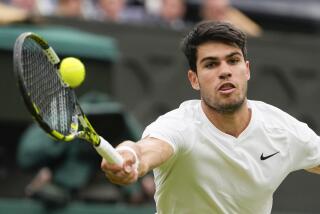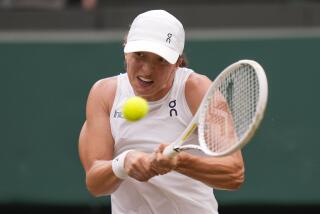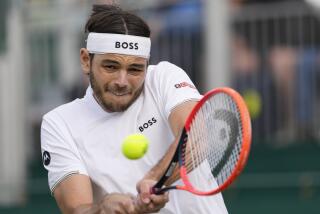COURT CHANGEOVER
- Share via
WIMBLEDON, England — Of all the spectacular vantage points from which to view a tennis match at the All England Club, this was the most unusual: Court 1, West Stands, first row.
To reach the seats required the cunning and sense of direction of a rat, a lathering of sunscreen against an insistent afternoon sun, and the willingness to scrunch against your neighbors into too-narrow and impossibly hard wooden seats.
And an interest in voyeurism: The row of seats was sunk into the sub-flooring beside the court, affording a worm’s-eye view of the court. There was a fine view of the players’ feet, but it was necessary to suddenly arch a neck to catch sight of any play that took place above the net.
To say that Court 1 provided an intimate atmosphere was entirely accurate.
“You always felt like the spectators on that side were looking up your skirt,” Chris Evert said.
The rickety, 6,500-seat stadium was a perilous and precious venue at Wimbledon, unforgettable for players and fans. So peculiar was it, that it would never be allowed to be played on if it were built today.
“The court was small, it was shady on one side, it was sloped, if it was damp you’d slip all over the place. I liked it,” said Evert, a three-time Wimbledon champion.
“It was intimate. Small. It was better for a serve and volleyer. There was so little room that you could run off the court getting to a ball. It was not the best place for a baseliner. I was never really comfortable. But it was interesting. It was Wimbledon.”
Beloved Court 1 has now been relegated to Wimbledon lore, having been closed to make way for expansion and modernization--never principles associated with the stately and glacial All England Club.
The new Court 1 will be used for the first time this year. The 11,000-seat oval stadium is meant to fit into the Club’s theme of “Tennis in an English Garden.” The overall look may be achieved when the ivy crawls up the stadium’s concrete walls, and finds more harmony with the ivy-covered Centre Court.
In 1996 the shell of the stadium had been erected and its hulking presence startled those who walked into the grounds for the first time that year. Hard-core traditionalists were dismayed at the building’s dominating presence. Court 1’s modernity was announced loudly to anyone walking up Church Road toward the All England Club. It’s a jarring scene.
Given the prestige and power of the All England Club’s membership, it has been politically expedient to approve of the changes at Wimbledon. The very weight of the members’ titles and high-level business associations seems to have thrown a Teflon blanket over the entire building project.
Comment, such as it’s been, has been polite. A British architectural magazine recently described the new Court 1 as “magnificent,” a surprisingly gushing review of such a ho-hum edifice.
Even the Royal Institute of British Architects, which comments on the appropriateness of most public buildings in the country, has remained mum. Tony Chapman, press officer for the RIBA, was amused by questions regarding the new Court 1.
“Let’s put it this way,” he said. “I’ve not heard anyone who’s been publicly critical of it.”
As would be expected of Wimbledon, a ceremony has been planned to commemorate the opening of the new court before Monday’s first match. All of the usual Wimbledon patrons will be trotted out--the Duke of Kent, the president of the Club, Gentlemen and Ladies’ singles champions who have won more than three titles, and an array of “celebrities.”
There has been no tennis played on the court. As part of the celebrations, however, a televised religious performance, Songs of Praise, was taped at Court 1 on June 1 and will be shown on BBC during the Championships.
The new court is the first stage of the All England Club’s three-stage long-term construction plan, which was unveiled in 1993. The plan, which the reserved Club officials have named the Long Term Construction Plan, is the most ambitious renovation since the Club relocated to its current site in 1922. The entire project will reportedly cost $125 million.
Central to this and any other theme involving Wimbledon is the notion of tradition. Thus, this and all future construction will adhere to the club’s peculiar hierarchy: There is Centre Court, the show courts, and the rest. Nothing may ever be allowed to encroach on the dominant position of Centre Court.
To satisfy that mandate, designers had to tweak the plans a bit. The new court was actually drawn from Stanley Peach’s original Centre Court design. The circular shape mimics Centre Court’s but was not made on such a grand scale.
Like Centre Court, the new Court 1 is four stories high. But Club officials would never approve of Court 1 appearing to be as tall as Centre Court. Engineers countersunk the stadium into a hillside so that its roof line would be no higher than Centre Court.
The sinking achieves the effect, according to Club plans, of serving to “underline its desired status as the younger brother.”
Designers even built Court 1’s partial roof overhang so that the first shadows hit the baseline at the same moment as they do on Centre Court--5:40 p.m.
Construction began after the 1994 Championships on a site that included a gently sloping hill at Aorangi Park. The hill was first stabilized by driving piles into the sides. The site was leveled and additional piles, some 2,000 in all, were driven into the soil at the site of the new court and the building.
Work was halted during the 1995 and 1996 championships and the public was allowed to tour a portion of the construction site. In 1995 the giant maw of a hole in the ground did little to spark the imagination of fans. Many were still angry at the loss of their beloved picnic grounds.
This year’s Championships will return to the public its traditional picnic grounds, although more official and less impromptu. Now called the Aorangi Picnic Terrace, brown-baggers will be treated to the inviting prospect of what planners call “soft landscaping”: turf, trees and shrubs. Another new-fangled addition is a large viewing screen that will give fans a view of play on all courts.
Not everything is as traditional as it may seem. The new facility is brimming with income-generating opportunities, including five food courts and an outlet of the extravagantly priced Wimbledon Shop. The forward-thinking Club members even allowed an American-style addition: 11 hospitality suites.
One thousand fans already have paid some $17,000 for a five-year “debenture,” or ticket, solely for the new court.
The site of the old Court 1 is a demolition in progress. The North Stand and the Lower West Open Stand have been demolished. The remains will be cordoned off during the tournament and further redevelopment will take place after the tournament. A walkway along the west side still will be used.
When construction begins in earnest, a facilities building will be erected on the site. The building will house an expanded players’ lounge and a new press center.
Also on the old site will be an extension of Centre Court, which will add 700 seats and some television commentary boxes. The new changes are scheduled to be in place by the year 2000.
There are few places in sport where grass is as precious or as meticulously tended as at Wimbledon. Long before the structure of the building was taking shape, the new court’s surface was being formulated. After lengthy consultations, Wimbledon officials elected to go with 70% rye grass and 30% creeping red fescue. This was grown from seed at a site in Yorkshire, in soil supplied by the All England Club.
Once established, the grass was brought to Wimbledon in September 1995 to allow it to “acclimatize” to its new home. There, about 860 tons of materials--beginning with a rock and stone base and layers of soil--were laid down before even a blade was set in place.
The Head Groundsman and his team have tended to their new charge since then.
So well-maintained was the sod at the old Court 1 that it was taken up and sent to Eastbourne, site of the women’s Wimbledon warmup tournament.
(BEGIN TEXT OF INFOBOX / INFOGRAPHIC)
Wimbledon at a Glance
* WHEN: Monday-July 6
* TOP-SEEDED MEN: 1. Pete Sampras, United States; 2. Goran Ivanisevic, Croatia. 3. Yevgeny Kafelnikov, Russia. 4. Richard Krajicek, Netherlands.
* TOP-SEEDED WOMEN: 1. Martina Hingis, Switzerland. 2. Monica Seles, United States. 3. Jana Novotna, Czech Republic. 4. Iva Majoli, Croatia.
* DEFENDING MEN’S CHAMPION:
Krajicek
* DEFENDING WOMEN’S CHAMPION: Steffi Graf
* LAST AMERICAN MEN’S
CHAMPION: Sampras, 1995
* LAST AMERICAN WOMEN’S
CHAMPION: Martina Navratilova, 1990
More to Read
Go beyond the scoreboard
Get the latest on L.A.'s teams in the daily Sports Report newsletter.
You may occasionally receive promotional content from the Los Angeles Times.











